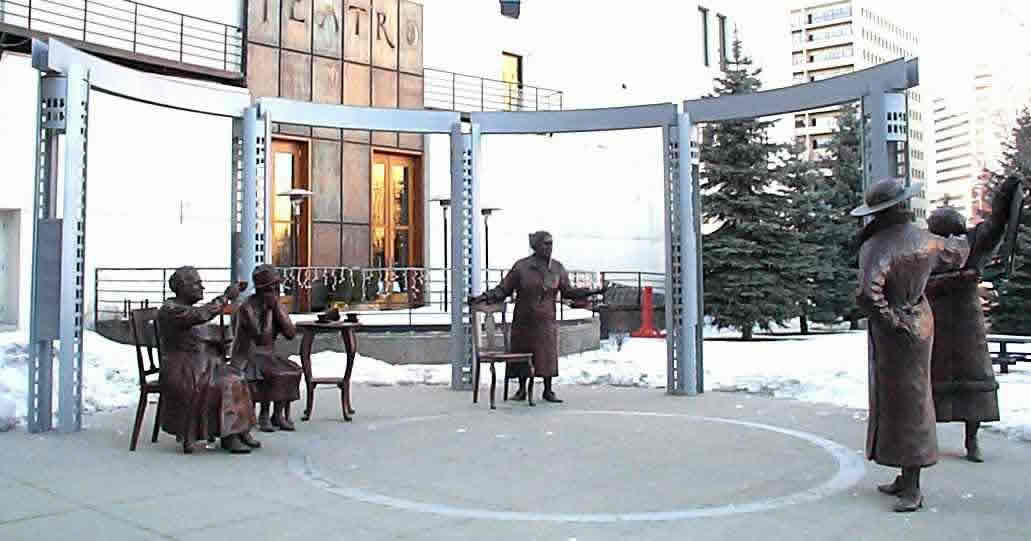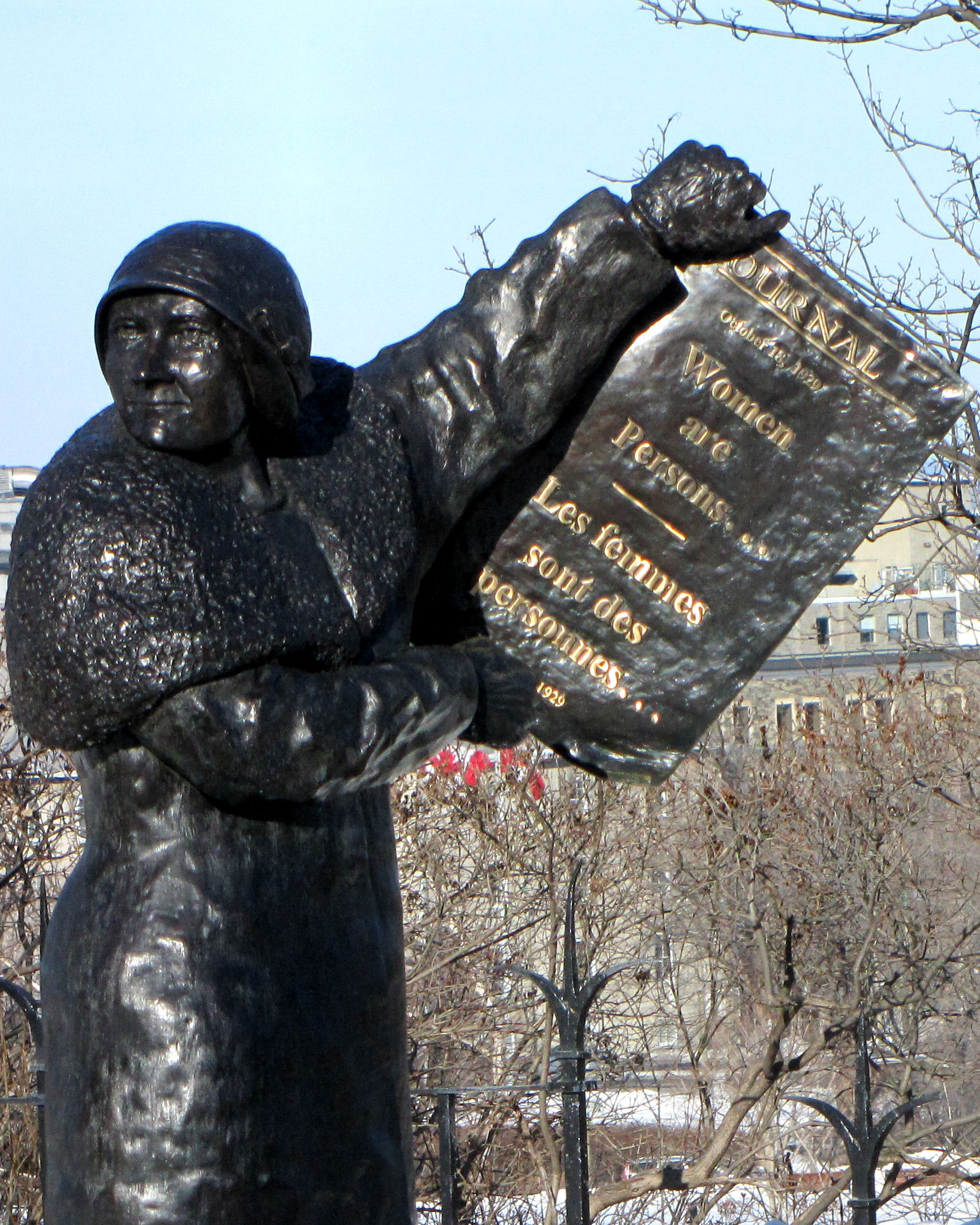By D. Gordon E. Robertson (Own work) [CC-BY-SA-3.0
(www.creativecommons.org/licenses/by-sa/3.0) or GFDL (www.gnu.org/copyleft/fdl.html)], via Wikimedia Commons |
The Famous Five
 |
| By Eugene M. Finn / National Film Board of Canada [Public domain], via Wikimedia Commons |
The statues in situ
A bronze sculpture of the Five was created by Barbara Paterson, showing them standing and sitting, talking and taking tea. Two 1 and 1/4 life-sized copies exist, one on Parliament Hill in Ottawa and one in downtown Calgary. Last year, a similar group of statues by Helen Granger was unveiled in Winnipeg, outside the Manitoba Legislature.
By Philip Tellis (originally posted to Flickr as Tea Party) [CC-BY-SA-2.0
(www.creativecommons.org/licenses/by-sa/2.0)], via Wikimedia Commons. The wooden surface on which the figures stand is level; the seasickness is trick photography. |
When I came upon the group on Parliament Hill for the first time, knowing of the landmark legal case but not of the existence of the statues, they were a lovely surprise. They were being polished by two of the park custodians, with their portable litter bins and hi-viz jackets. I found it poignant to see the two men giving such care and attention to these five women.
The image below is from Olympic Square in Calgary, unveiled in 1999. The young royals are going there too -- to the city, but I doubt if they will be shown the statues.
By User Thivierr on en.wikipedia [Public domain], via Wikimedia Commons
|
Less well documented is the set of statues in Winnipeg. (There is an article and photo of its unveiling in the Winnipeg Free Press, 18 June 2010.)
The artistic process
Paterson's work is represented by Willock and Sax, the Banff National Park Gallery of Fine Art and Photography. If I understand correctly, the sculpture project was spear-headed by the Famous 5 Foundation, which exists to celebrate leadership in women, and runs events and programmes, many targeted at youth. It is based in Alberta, as were the Famous Five. A few words on the artistic and administrative process from the gallery website:
In order to secure the commission for the Famous 5 monuments, being one of nineteen people approached to submit a proposal, Barbara tendered drawings as well as recommendations (final size 1 1/4 lifesize, ground level, interactive), which were taken up by the jury. The three 'finalists' from the first round presented maquettes (in the wax stage) at 1/4 size of the final 1 1/4 lifesize monument.
It was decided by the Monument Project Jury that Barbara's concept was the one that best encapsulated the idea of the five women who became known as the Famous 5. When Barbara's maquette secured her commission that work was cast in bronze, which travelled across Canada to generate interest in the Monument project....
In 1999 the first monument was installed in Calgary (Olympic Square) and in 2000 the second monument was installed east of the Centre Block of the Parliament Buildings in Ottawa. Remember that the monuments are 1 1/4 lifesize, so when you sit on Emily's Chair think of Alice in Wonderland.
The women themselves
The Five were Famous for good reasons individually as much as collectively. Three of the sculpted figures are standing, starting with the woman granted the central position in the artistic composition. The one holding the declaration, Nellie Mooney McClung, is probably the most famous Canadian suffragist, below:
By D. Gordon E. Robertson (Own work) [CC-BY-SA-3.0
(www.creativecommons.org/licenses/by-sa/3.0) or GFDL (www.gnu.org/copyleft/fdl.html)], via Wikimedia Commons |
The figure with her hand on the (Alice in Wonderland) chair is Emily Murphy, the first female judge in the British Empire:
 |
| By en:User:Montrealais (Own work) [GFDL (www.gnu.org/copyleft/fdl.html)], via Wikimedia Commons |
The woman with her arm outstretched and her other hand on her hip is Irene Parlby, a farm women's leader who became the first female cabinet minister in Alberta:
By User:Thivierr (Digital camera photo taken by uploader)
[GFDL (www.gnu.org/copyleft/fdl.html) or CC-BY-SA-3.0 (www.creativecommons.org/licenses/by-sa/3.0/)], via Wikimedia Commons |
Two of the women are sitting, taking tea together, either side of a small table.
By D. Gordon E. Robertson (Own work) [CC-BY-SA-3.0
(www.creativecommons.org/licenses/by-sa/3.0) or GFDL (www.gnu.org/copyleft/fdl.html)], via Wikimedia Commons |
The one with her cup raised, gesturing towards the "Women are persons" declaration, is Henrietta Muir Edwards, founder of the Victorian Order of Nurses:
By D. Gordon E. Robertson (Own work) [CC-BY-SA-3.0
(www.creativecommons.org/licenses/by-sa/3.0) or GFDL (www.gnu.org/copyleft/fdl.html)], via Wikimedia Commons |
The other one, with her hands clasped, is Louise Crummy McKinney, the first woman elected to the legislature of Alberta (and Wikipedia says the first so elected anywhere in the British Empire -- but I thought New Zealand got there first?):
Notice the clothes: some are in dresses, some in coats and furs; some with hats, some hatless, as if indoors. And the snow settles on them all...
By User:Thivierr (Digital camera photo taken
by uploader) [GFDL (www.gnu.org/copyleft/fdl.html) or CC-BY-SA-3.0 (www.creativecommons.org/licenses/by-sa/3.0/)], via Wikimedia Commons |
I've collected (I refuse to say "curated") various images into Flickr galleries, gathered for those who like slideshows: the Calgary statues, the Ottawa statues, and the Winnipeg statues.
In a later post, I'll show how people show their love for them. That will have to wait a while, though. It is national celebration month, so next week, celebratory memorial sculptures from the United States (I have two groups of activists in mind), and the week after that, Storm the Bastille with public outdoor art from France. Vive la revolution!








No comments:
Post a Comment